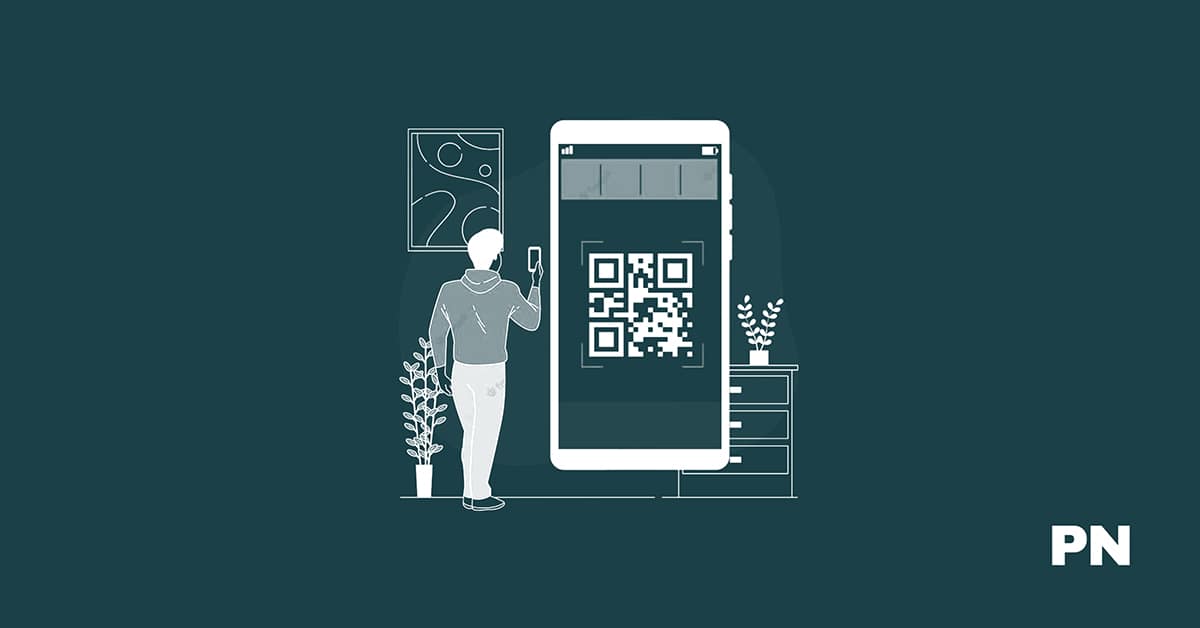40+ Important QR Code Statistics You Should Know

QR codes have revolutionized how we interact with the world, from scanning a code to accessing a website to making payments.
Did you know that as of 2023, 44.6% of internet users had scanned a QR code at least once?
Yes, QR codes have become part of our daily lives.
As smartphone adoption continues to increase, so does the usage of QR codes.
In 2022, around 89 million mobile device users in the US engaged with QR codes, marking a 26% increase from 2020.
Furthermore, between 2022 and 2025, the number of consumers in the United States who scan QR codes with their smartphones is predicted to increase by 16 million.
In this article, we will explore the latest QR code statistics and trends to comprehensively understand QR codes’ impact on various industries.
1. Smartphone adoption is driving an increase in QR Code scans worldwide.
(Source: Statista)
QR codes have existed for over two decades but have become more ubiquitous recently. This is largely due to the increasing adoption of smartphones.
According to a report by Bankmycell, there will be 6.64 billion smartphones worldwide in 2022, projected to reach 7.33 billion by 2025.
With more people owning smartphones, the potential audience for QR codes has grown significantly.
The rise in smartphone ownership has also led to increased internet usage.
As more people have access to the internet, they are more likely to use QR codes to access information.
A report by Scanova shows that global smartphone penetration has skyrocketed from 3.2 billion in 2016 to an estimated 6.8 billion in 2023, an annual increase of 4.2%.
Businesses have also noticed the growing popularity of QR codes.
Many have started using them to engage with customers and provide them with more information.
For example, QR codes can provide customers with product information, discounts, and other incentives.
They can also streamline the checkout process by allowing customers to scan and pay for items using their smartphones.
2. In 2022, around 89 million mobile device users in the US engaged with QR Codes, marking a 26% increase from 2020. This figure will rise to 100 million by 2025.
(Source: Statista)
QR codes have become increasingly popular in recent years, which is expected to continue in the coming years.
This increase in usage can be attributed to several factors, including the growing popularity of mobile devices and the ease of use of QR codes.
One reason for the increased usage of QR codes is their versatility. QR codes can be used for various purposes, including marketing, payments, and ticketing.
For example, many businesses use QR codes to give customers easy access to product information, discounts, and promotions.
QR codes can also be used to make payments, eliminating the need for customers to carry cash or credit cards.
Another reason for the increased usage of QR codes is their convenience. QR codes can be scanned quickly and easily using a smartphone camera, making them an ideal tool for busy consumers.
In addition, many businesses are using QR codes to streamline their operations, reducing the need for paper-based processes and improving efficiency.
The increased usage of QR codes in the US is a positive trend that is expected to continue in the coming years.
3. Between 2022 and 2025, the number of consumers in the United States who scan QR codes with their smartphones is predicted to increase by 16 million.
(Source: Statista)
One of the reasons for this increase is the growing popularity of mobile devices.
As more people use smartphones and tablets to access the internet, QR codes are becoming increasingly important for businesses and organizations to reach their target audiences.
QR codes are easy to use and can be scanned, which makes them an attractive option for consumers looking for a fast and convenient way to access information.
Another factor driving the growth of QR codes is the increasing availability of mobile payment systems.
Many businesses now use QR codes to accept customer payments, making it easier for people to purchase via mobile devices.
This is particularly important in a world where more and more people are using their smartphones to shop online.
The increasing popularity of QR codes indicates the growing importance of mobile devices in our daily lives.
4. The Global QR Code Payment Market has surged, reaching a valuation of USD 10.28 billion in 2022, and is predicted to continue growing at a CAGR of 17.03% until 2028.
(Source: Yahoo Finance)
QR code payment has become increasingly popular in recent years due to its convenience, speed, and ease of use.
This growth is driven by several factors, including the rise of usage, particularly in developing countries, and the increasing popularity of mobile payments.
According to a report by Allied Market Research, the global QR code payment market is projected to reach USD 35.07 billion by 2030, growing at a CAGR of 16.1% from 2021 to 2030.
QR code payment offers a simple interface for quick money transactions anywhere and anytime.
It is considered a fast, versatile, and secure payment method that eliminates the need for physical cash or cards.
The technology is also cost-effective for businesses, eliminating the need for expensive point-of-sale terminals and reducing transaction fees.
5. As of 2023, 44.6% of internet users had scanned a QR code at least once.
This is likely due to the increased popularity of contactless payment and checkout services, which are anticipated to make up 80% of all payments by 2024.
QR codes are also increasingly being used for marketing purposes. In fact, 6 out of 10 customers love getting digital coupons, which led to a 323% growth in QR code usage in 2021-2023.
Overall, QR code use is expected to continue growing in the coming years, with Juniper Research predicting that the number of users using QR codes will exceed 2.2 billion in 2025.
6. 90% of participants used a QR code within the previous month.
(Source: Statista)
QR codes range widely, from marketing and advertising to ticketing and payments.
Their versatility and ease of use have made them a popular choice for businesses looking to engage with customers in new and innovative ways.
One of the main advantages of QR codes is the ability to access information.
Customers can access product information, special offers, and other relevant content by scanning a code with their smartphone.
This makes QR codes an effective tool for driving engagement and increasing sales.
Another benefit of QR codes is their low cost and ease of implementation.
Unlike traditional advertising methods, QR codes can be created and distributed quickly and easily, with minimal investment.
It is an attractive option for small businesses and startups looking to reach a wider audience.
The growing use of QR codes indicates their effectiveness as a marketing and communication tool.
7. QR code adoption was expected to increase by 323% between 2021 and 2023.
(Source: The Enterprise World)
As of 2024, the United States is at the forefront of global QR code usage, accounting for 42.2% of global scans from 2022 to 43.9% of 2023.
This is a striking increase of 10.72%, and it is expected to continue to rise in the coming years.
In addition, dynamic QR codes generated by users accumulated 6,825,842 QR code scans from global users in 2024, a 433-percent increase over the 2021 figures.
This shows that more and more people are using QR codes for various purposes, such as marketing, payments, and information sharing.
It is also worth noting that contactless payments in the US have surged 150% since March 2019, and 80% of costs and checkout services are anticipated to be contactless by 2024.
This is due partly due to the COVID-19 pandemic, which has accelerated the adoption of contactless commerce.
Whether you are a business owner looking to market your products or a consumer looking to make a quick and easy payment, QR codes are a valuable tool that can help you achieve your goals.
8. The worldwide search volume for the “QR Code” keyword has reached 2.5 million.
(Source: Ahrefs)
QR codes will likely become even more prevalent as the world becomes more digital.
With the rise of contactless payments and the need for touchless solutions due to the COVID-19 pandemic, QR codes have become essential for businesses and individuals.
9. Global QR code usage statistics recorded 26.95 million scans in over 50 countries.
(Source: QR Tiger)
Smartphone usage is the primary catalyst for the QR code upsurge.
The United States is at the forefront of global QR code usage, accounting for 42.2% of global scans from 2022 to 43.9% of 2023 —a striking increase of 10.72%.
10. The top industries with the most QR code usage are Retail (42%), Restaurant (41%), Logistics (83%), Travel and Tourism (210%), and Marketing and Advertising (323%).
(Source: QR Tiger)
Retail and restaurant industries have quickly adopted QR codes, and their usage has only increased.
With QR codes, customers can quickly access product information, pricing, and promotions, making the shopping experience more convenient and efficient.
Logistics is another industry that has seen a significant increase in QR code usage.
QR codes are used for inventory and delivery, making the entire logistics process more streamlined and efficient.
The travel and tourism industry has also seen a significant increase in QR code usage.
QR codes are used for hotel check-ins, boarding passes, and tour information, making the entire travel experience more convenient and hassle-free.
Finally, the marketing and advertising industry has seen the most significant increase in QR code usage.
QR codes provide customers with promotional offers, product information, and even augmented reality experiences.
QR codes have become an essential tool for businesses in various industries, and their usage is only expected to increase in the coming years.
11. 84% of mobile users scanned a QR code at least once.
(Source: Business Wire)
QR codes have become so popular because they are easy to use.
You can scan any QR code with a smartphone, camera, and reader app.
This ease of use has made QR codes a popular marketing tool for businesses, as they can provide customers with quick access to information or promotions.
12. 72% of individuals scan a QR code at least once a month, and 32% scan a QR code every week.
(Source: Business Wire)
Many businesses have started using QR codes to provide contactless payment options and reduce the virus’s spread.
QR codes have also been used to inform customers about safety protocols and track the spread of the virus.
13. 18.8% of US customers feel they have witnessed an increase in the use of QR codes since the pandemic.
(Source: Statista)
From menus to advertisements to event tickets, QR codes seem everywhere.
This increase in QR code usage can be attributed to a few factors.
First, the pandemic has forced many businesses to go contactless, and QR codes provide a convenient way for customers to access information without touching anything.
Second, QR codes can be used for various purposes, from making payments to accessing websites, making them a popular choice for businesses.
But it’s not just businesses that use QR codes more frequently. Consumers are also starting to embrace them.
So, what does this mean for you?
Well, if you’re a business owner, you know that apps are becoming an increasingly important tool for engaging with customers.
Whether you’re using them to provide services or offer discounts, QR codes can help you connect with your audience in new and innovative ways.
And if you’re a consumer, it’s worth learning about QR codes and how they can benefit you.
By scanning a QR code, you can quickly access information about a product or service, make a payment, or even enter a contest.
So the next time you see a QR code, don’t be afraid to scan it; don’t worry about what it sees.
14. The number of smartphone users in the US is predicted to reach 99.5 million in 2025, up from 83.4 million in 2022.
(Source: Business Insider)
Most smartphone cameras recognize QR codes, so users can easily scan codes to access information, promotions, and other content.
The COVID-19 pandemic has also accelerated the adoption of QR codes as a contactless payment and ordering solution, further driving their usage.
As the number of smartphone users scanning QR codes continues to rise, businesses and marketers should consider incorporating QR codes into their marketing strategies.
15. The QR code labels market is expected to reach $2.1 billion by 2027, increasing at a CAGR of 8.9%.
(Source: Future Market Insights)
With the increasing use of smartphones and the growing trend of online shopping, QR codes are becoming more popular among consumers.
QR codes can be easily scanned using a smartphone camera, making them a convenient tool for customers to access information about products and services.
16. QR Code creation has increased by 4x between 2021 and 2023.
Canada witnessed an outstanding 4x increase, escalating from 5,500 QR Codes in 2021 to an impressive 20,000 QR Codes by mid-2023.
Australia, the UK, and the UAE are among the top five countries with the highest QR Code creations in 2023.
The biggest jump in QR code usage occurred between 2020 and 2021, when COVID-19 hit and social distancing became a consumer priority.
Businesses had to move toward contactless customer interaction methods, and the QR code was the perfect solution.
Worldwide usage of QR codes for payments increased by nearly 50% during that time.
17. Bitly reported a 750% increase in QR code downloads in 2021.
(Source: CNBC)
Bitly’s report is a valuable source for marketers looking to incorporate QR codes into their marketing strategies.
By analyzing the data provided in the report, businesses can gain insights into the most effective ways to use QR codes to engage with their target audience.
Bitly’s significant increase in code downloads in 2021 is clear, clearly indicating increasing popularity and widespread usage.
Businesses and marketers should use this trend and incorporate QR codes into their marketing strategies to effectively engage with their target audience.
18. Black is the most common color for QR codes, preferred by 85% of users.
Black provides the highest contrast against a white background, making it easier for QR code scanners to read the code.
However, black is not the only option.
QR codes can be customized with different colors and designs.
The contrast between the code and the background is crucial for readability.
Hence, using colors too similar to the background can make the code difficult to scan.
In addition to color, the size of the QR code also plays a role in its readability.
QR codes that are too small may not be scannable, while codes that are too large may not fit on the intended surface.
Finding the right balance between size and readability is important to ensure that the code can be scanned easily.
19. 53% of consumers will likely provide personal information through a QR code scan.
It’s important to be transparent about how they use the information collected through QR codes.
Consumers are more likely to provide personal information if they trust the business and understand how their information will be used.
Therefore, businesses should clearly state their privacy policies and provide opt-out options for consumers who do not want to provide their personal information.
20. The Top Three Countries with the Highest QR Code Usage are China, India, and Nigeria.
(Source: Statista)
China, India, and Nigeria stand out as the top three nations with the highest QR code usage among the countries that have embraced QR code technology.
Since the development of QR code payments in 2011, China has used QR codes for everything from renting portable chargers to paying for groceries.
India is another country that has fully embraced QR code technology.
QR codes have become so ubiquitous in India that they are now used for everything from ordering food at restaurants to accessing public transportation.
Nigeria is another country that has been at the forefront of QR code adoption.
In Nigeria, QR codes are used for everything from mobile payments to accessing information about tourist attractions.
21. 68% of QR code users are between the ages of 24 and 54, with those aged 55 and over accounting for only 18% of all QR code users.
While QR codes may have initially been targeted towards younger generations, they have become a mainstream tool for businesses to engage with customers of all ages.
By understanding the demographics of QR code users and tailoring marketing strategies accordingly, businesses can effectively leverage this technology to drive engagement and sales.
22. Up to 30% of a QR Code can still be damaged and scannable.
(Source: Fast Company)
It is common for QR codes to become damaged or unreadable due to various reasons, such as printing errors, poor lighting, or damage to the code itself.
Despite this, up to 30% of a QR code can still be damaged and scannable.
This is due to the error correction capabilities built into QR codes.
QR codes have four error correction levels, which means that even if some parts of the code are damaged or missing, the code can still be read.
The error correction level is determined by the amount of data that needs to be stored in the QR code.
If the code contains a small amount of data, such as a URL or a phone number, it can have a higher error correction.
However, if the code contains a large amount of data, such as a PDF or an image, it will have a lower level of error correction.
23. In Australia, QR code usage surged during the COVID-19 pandemic for contact tracing purposes.
(Source: Uniqode)
QR codes have been widely used in Australia for contact tracing during the COVID-19 pandemic.
The Australian government has implemented mandatory QR code check-ins for businesses, which has led to a surge in QR code usage.
According to recent statistics, over 300 million check-ins have been recorded in New South Wales alone since the mandatory QR code check-in was introduced in November 2020.
This shows how QR codes have become an essential tool in contact tracing efforts and have helped to control the spread of COVID-19.
QR codes have made contact tracing easier and more efficient.
They allowed businesses to quickly and easily record the details of their customers, which were used to trace potential COVID-19 cases. This helped to reduce the spread of the virus, allowing businesses to remain open and protecting the health and safety of the public.
24. In 2022, the United States generated over 200,000 QR codes, a 248% increase over 2021.
(Source: Uniqode)
The COVID-19 pandemic accelerated the adoption of contactless technologies, including QR codes.
As people have became more cautious about touching surfaces, QR codes were a convenient and safe alternative to traditional payment methods and physical menus.
25. In 2022, the United States accounted for 74.78% of QR code scans worldwide, with 38 million scans.
(Source: Uniqode)
The rise of QR code scanning in the United States can be attributed to several factors, including the widespread adoption of smartphones and the convenience of scanning codes for various purposes.
Additionally, businesses have increasingly turned to QR codes to engage with customers and provide them with a seamless experience.
Other countries have also seen significant growth in QR code scanning, with China, Japan, and South Korea among the top players.
However, the United States remains the clear leader in terms of thof scans, with no signs of slowing down anytime soon.
26. In the United States, 45% of respondents utilized a marketing QR code at least once every three months.
(Source: The Drum)
27. 80% of payments and checkout services are expected to use contactless payment by 2024.
(Source: Gartner)
Contactless payments allow customers to make purchases without the need to touch a payment terminal.
This can be done through various methods, such as mobile wallets, QR codes, and near-field communication (NFC) technology.
With the rise of mobile payments and the increasing availability of contactless payment options, it’s no surprise that contait’sss payments are becoming the norm.
Contactless payments are quick and convenient.
Customers can simply tap their device or scan a QR code to complete a transaction without needing cash or a physical card.
This can save time and reduce the risk of spreading germs, making it a popular choice during the ongoing COVID-19 pandemic.
28. Approximately 89.5 million Americans will read QR codes using smartphones by 2024.
(Source: Statista)
The increasing adoption of contactless payment, digital menus, and online retail within US industries has contributed to promising QR Code forecasts.
In addition, QR codes’ ease of use has made it a popular choice for businesses and consumers alike.
Most smartphone cameras now recognize QR codes, making them easier to use.
29. By the end of 2022, 5.3 billion QR codes were used to redeem coupons.
(Source: Juniper Research)
QR codes are a convenient and efficient way for customers to redeem coupons.
Instead of printing out a physical coupon, customers can scan a QR code with their smartphone. This saves time and paper and is a more environmentally friendly option.
Moreover, by the end of 2022, over one billion smartphones had access to QR codes.
This means that QR codes are accessible to a large population, making them an effective marketing tool for businesses.
30. According to 59% of surveyed US customers, QR codes will become a permanent fixture in their lives.
(Source: Scanova)
One reason for this shift in perception is the convenience of QR codes.
They allow users to quickly access information or complete tasks without typing in a URL or searching for a specific website.
For example, QR codes can be used to quickly pay for items at a store, quickly access a menu at a restaurant, or download an app.
The rise of QR codes is also due to the increasing use of smartphones.
As more people use smartphones, QR codes will likely grow. In fact, 6.8 billion smartphone users worldwide will be present by 2023.
Overall, QR codes are becoming an increasingly important part of our lives. With their convenience, versatility, and growing popularity, they are clear known to stay.
31. The number of unique mobile phone users globally has surpassed 5.61 billion.
(Source: DataReportal)
This rise in mobile phone usage has been a driving force behind the increasing adoption of QR codes.
With more people using mobile phones, the capacity to scan QR codes is also increasing.
This has led to the widespread use of QR codes in various industries, including marketing, advertising, and retail.
With the growing popularity of mobile devices and the increasing adoption of QR codes, it is clear that this technology is here to stay.
32. Global smartphone penetration is expected to reach 6.4 billion in 2029.
(Source: Statista)
The increase in smartphone penetration can be attributed to various factors.
For example, the availability of affordable smartphones and technological advancements in mobile internet usage have increased smartphone penetration.
In fact, the number of mobile internet users is expected to surpass that of desktop internet users shortly.
Furthermore, the search results suggest that the number of smartphone users is expected will rise in the coming years.
The number of smartphone users is forecasted to increase by 1.5 billion by 2029, an increase from the current number.
As more people gain access to smartphones, the opportunities for businesses to reach out to their customers through mobile channels will continue to grow.
33. QR code creation increased by 43% in 2023.
(Source: QR Code Kit)
QR codes offer many benefits to businesses and consumers, including easy access to information, contactless payments, and improved marketing strategies.
As more people become familiar with QR codes, the number of QR codes created will likely grow even more.
34. Large brands like Starbucks, IKEA, General Motors, Walmart, and Nike utilize QR codes.
By incorporating QR codes into their marketing strategies, these companies have reached a wider audience and provided a more engaging customer experience.
Starbucks, for example, uses QR codes in its mobile app to allow customers to pay for their purchases and earn rewards.
Customers can also use the app to order ahead and skip the line.
IKEA uses QR codes to provide additional product information and inspiration to customers as they walk through the store.
General Motors uses QR codes in its advertising campaigns to direct customers to its website or provide additional product information.
Walmart has also implemented QR codes in their customers’ access to product information and pricing.
Nike uses QR codes in their retail stores to provide customers with access to exclusive content and promotions.
By incorporating QR codes into their marketing strategies, these companies have provided a more engaging customer experience and increased customer loyalty.
35. In the United States, 54% of respondents aged 18-29 and 48% aged 30-44 utilized a marketing QR code.
(Source: The Drum)
QR codes aren’t limited to marketing.
They can also be used for various purposes, such as event registration, product information, and payment processing.
As such, QR codes have the potential to become even more prevalent in the US as more businesses and organizations adopt them for different use cases.
36. 13% of Latin Americans use QR Codes.
(Source: Global Web Index)
This is a significant percentage, considering that the total population of Latin America is over 650 million people.
QR codes are used for various purposes in Latin America, including payments, advertising, and marketing.
In some countries, QR codes are used to access government services and information.
For example, in Mexico, QR codes are used to access information about public transportation; in Brazil, they are used to access information about public health services.
Compared to other regions, Latin America has a lower percentage of QR code users.
For example, 15% of the Asia Pacific population uses QR codes, and 10% of Europeans and Middle East Asians use QR codes.
However, the use of QR codes is expected to continue to grow in Latin America as more businesses and organizations adopt this technology.
If you live in Latin America, you are likely to have encountered QR codes in your daily life.
Whether you use them to make payments, access information, or participate in marketing campaigns, QR codes are a convenient and efficient way to interact with the world around you.
37. QR scanners are built-in on 91% of iOS and 86% of Android devices.
The introduction of built-in scanners has made it much easier for users to scan QR codes without downloading additional apps.
This has led to an increase in the usage of QR codes, as more and more people are able to scan easily.
You can check your camera app if you’re unsure whether you have a built-in QR scanner.
Most modern camera apps have a feature that allows you to scan QR codes simply by pointing your camera at them.
Overall, the fact that QR scanners are built-in on the majority of modern smartphones is a testament to the growing popularity of QR codes.
38. 80% of users in the United States trust QR codes.
(Source: Scantrust)
QR codes have been around for over two decades, but their use has increased in recent years.
QR codes are also being used for marketing purposes.
Overall, QR codes are versatile and convenient tools that can be used in a variety of settings. With an increasing number of users trusting QR codes, their use is likely to continue growing in the coming years.
39. 95.7% of Chinese users prefer the QR code payment method.
(Source: Payment & Clearing Association of China)
QR codes are the most popular method for mobile payments in China.
In addition, QR code payments are widely accepted in China, with many businesses and services, such as restaurants, taxis, and street vendors, accepting them.
This has made QR code payments a part of everyday life for many Chinese people.
QR code payments are also very secure, as they use encryption and tokenization to protect users’ financial information.
This makes them a safe and reliable method of payment for both consumers and businesses.
40. Chinese users engage with QR codes 10-15 times a day.
(Source: Go Click China)
The report also highlights that over 50% of the Chinese population uses QR codes several times a week.
This is a significant increase from just a few years ago, and it demonstrates the growing popularity of QR codes as a means of accessing information and making transactions.
According to Go Click China, in 2020, China registered QR code transactions totaling $5.5 trillion.
This staggering figure underscores the importance of QR codes in the Chinese economy.
QR codes are used for a wide range of applications in China, from mobile payments and ticketing to marketing and advertising.
A number of factors have driven the widespread adoption of QR codes in China, including the technology’s ease of use.
QR codes are simple to scan and can be used to access a wide range of information and services.
41. India ranks second, with a total of 1,101,723 million QR code scans.
India has emerged as a major player in the QR code market, ranking second in the world in terms of total scans.
In addition to its high number of scans, India also ranks well in terms of the number of QR codes generated.
The country ranks third in the world, with a total of 3,727,067 codes generated.
This indicates that there is a significant demand for QR codes in India and that businesses and individuals are actively using them to drive engagement and transactions.
42. 61% of Japanese customers have scanned a QR code.
QR codes have become increasingly popular in Japan, where they were first invented.
Some of the most common uses of QR codes in Japan include:
- Making payments: Many stores and restaurants in Japan accept payments made via QR codes.
- Accessing information: QR codes are often used on product packaging to provide customers with additional information about the product.
- Advertising: QR codes are frequently used in advertising campaigns to provide customers with discounts or other special offers.
If you are a business owner in Japan, you should consider incorporating QR codes into your marketing strategy.
By making it easy for customers to scan a QR code and access information about your products or services, you can increase engagement and drive sales.
43. QR codes are used by 57% of women and 43% of men.
(Source: ResearchGate)
Overall, QR codes are useful and convenient tools for individuals and businesses.
As their popularity continues to grow, we can expect to see even more innovative uses for QR codes in the future.
Conclusion on QR Code Statistics
QR codes have become increasingly popular in recent years, with businesses and individuals alike harnessing their power to facilitate seamless information and product sharing.
The QR code statistics presented in this article demonstrate the growing popularity of this technology around the world.
It is clear that QR codes are here to stay, and businesses that utilize them effectively can benefit from increased engagement and improved customer experiences.
Disclosure: We may earn commissions if you buy via links on our website. Commissions don’t affect our opinions or evaluations. We’re also an independent affiliate of many platforms, including ClickFunnels, Kartra, GoHighLevel, Podia, Northwest Registered Agent, and others. We’re not employees of these services. We receive referral payments from them, and the opinions expressed here are our own and are not official statements of these companies.





